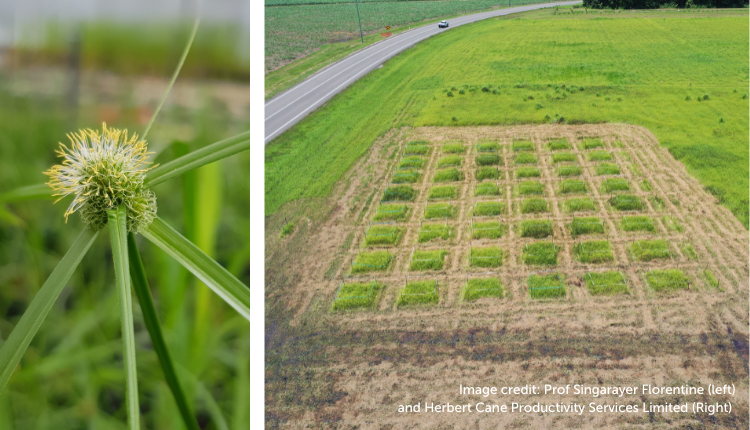Why invasive species matter for restoration ecology

Image caption: Navua Sedge weed flower head (pictured left) and herbicide trial fieldwork in Queensland (pictured right).
Professor Singarayer “Florry" Florentine has more than two decades of experience in restoration ecology and invasive species science. However, he didn’t realise how strongly connected they were until after finishing his PhD.
Prof Florentine came to Australia to do his doctorate, where he studied mining-site rehabilitation and became interested in restoration ecology – the science of returning disturbed landscapes back to their natural, sustainable state.
When he started working as a weed scientist, it clicked: Restoration ecology and invasive species ecology go hand-in-hand, since invasive species often thrive in environments where land has been disturbed by anything from land clearing to natural disasters.
“Restoration ecology was a new field of science at the time, but it called to me,” Prof Florentine says. “I wanted to contribute my research and expertise to work in this new field and help to restore the environment.”
During the past 22 years, he's worked in Australian universities leading research projects, supervising postgraduate and honours students, and developing courses on restoring ecosystems and dealing with invasive species.
At Federation, he’s one of three directors of the Future Regions Research Centre (FRRC), where he has established a well-recognised Invasive Species and Restoration Research Group. Their work has resulted in international recognition, with Prof Florentine being published in high-impact journals, and they have been awarded industry research grant funding.
Prof Florentine leads several partnerships with Local and State government groups around Australia to collaboratively research new approaches to protect landscapes and agricultural properties from invasive-species impacts.
For example, in partnership with Biosecurity Queensland, Together, a project has been developed to reduce the impacts of the aggressive weed species Navua sedge. This weed impacts agricultural industries by competing with crops for nutrients, light and moisture, and is especially problematic for sugarcane farming.
Prof Florentine’s team are researching more effective herbicides that target the rhizome, a part of the plant that grows under the soil’s surface. They hope to soon have data that can better inform management for the industry.
He says university-led collaboration with a range of different stakeholders, researchers and industry partners is important to bring multiple perspectives together to tackle large, complex environmental problems.
“We need to look at problems at the landscape scale, not just focusing on individual species,” Prof Florentine says.
“We need to find new innovative approaches and explore issues from different angles, using our collective knowledge from Australia and across the world.”
Interested in learning more about Florry’s research? You can read his most recent publications about habitat restoration and invasive species in Science Direct’s Global Ecology and Conservation and CSIROs Australian Journal of Botany.